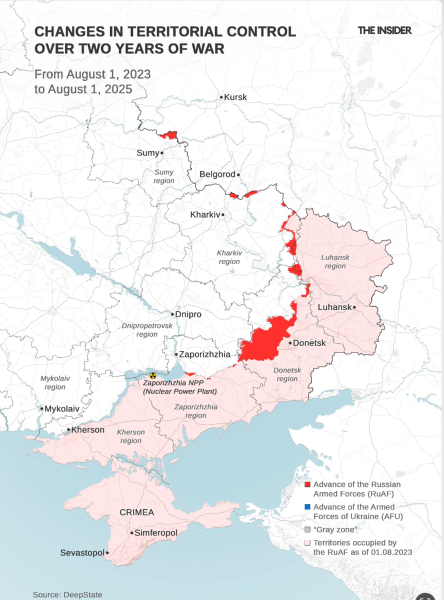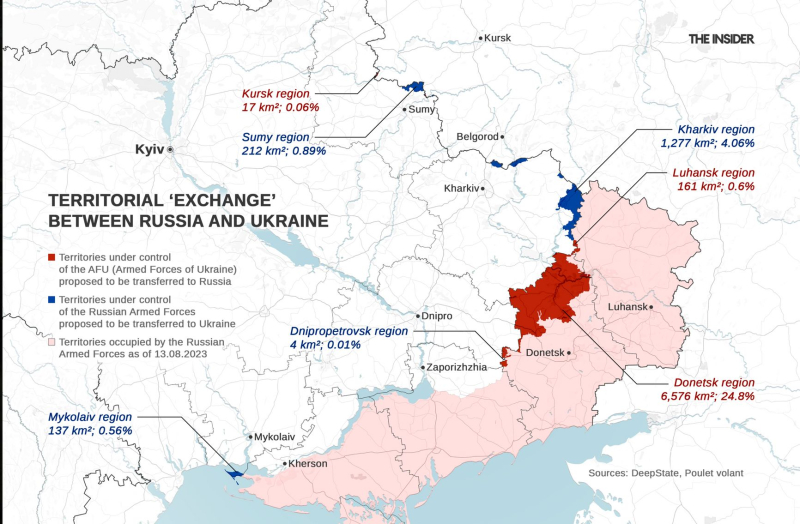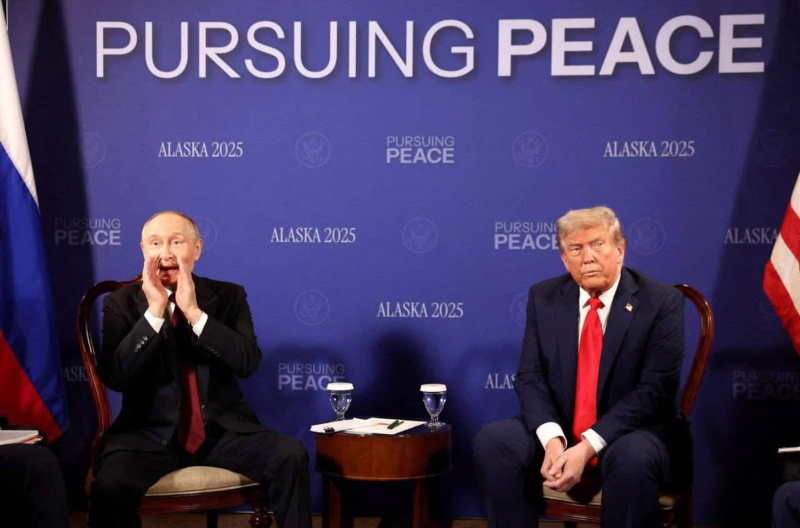Following last Friday’s talks with Vladimir Putin in Alaska, Donald Trump announced that one “big issue” remained unresolved — and all signs suggest it is what the Kremlin likes to call a “territorial exchange,” which in practice would mean handing over to Russia the areas of the Donetsk region that Moscow’s forces still do not occupy. Both Volodymyr Zelensky and the majority of Ukrainians are firmly opposed to giving up any land without a fight, and capturing the “fortress cities” of Sloviansk and Kramatorsk is far beyond the reach of the Russian military anytime in the near future. After the strong show of support that European leaders gave Zelensky during his trip to Washington three days after the Alaska summit, Putin’s demands appear more unrealistic than ever.
Since October 2023, Russian forces have been pressing an almost nonstop offensive, holding the clear military initiative ever since Ukraine’s counteroffensive failed to make substantive territorial progress. Yet the scale of Russian gains pales in comparison to the enormous material and human resources expended to achieve them.
DeepState is a Ukrainian project that maintains a regularly updated map of territorial control in the war zone and publishes frontline reports based on open-source intelligence (OSINT) as well as information provided by Ukrainian military sources.
Igor Girkin — a former Russian FSB officer better known by his alias Igor Strelkov (“Shooter”) — was one of the separatist field commanders in Donbas in 2014 and is now a well-known pro-war blogger. He was sentenced by a Dutch court to life imprisonment for his role in the downing of commercial flight MH17 over Donbas in 2014. In January 2024, the Moscow City Court handed him a four-year prison term for publicly inciting extremism.
Since 2022, shifts in territorial control in Ukraine have all but ceased
As of August 14, 2025, Russian forces occupy 114,479 square kilometers within Ukraine’s internationally recognized borders — but a mere 5,600 of those have been taken since August 1, 2023. Although Russia celebrated the announcement in September 2022 that it was annexing four Ukrainian regions, Ukrainian forces still control around 6,500 square kilometers in the Donetsk region, 7,300 in Zaporizhzhia, and 7,900 in Kherson. The only region formally annexed by Russia in October 2022 that is almost entirely occupied by its forces is Luhansk, where Ukrainian troops now hold barely 160 square kilometers — just 0.6% of the total area.
DeepState is a Ukrainian project that maintains a regularly updated map of territorial control in the war zone and publishes frontline reports based on open-source intelligence (OSINT) as well as information provided by Ukrainian military sources.
Igor Girkin — a former Russian FSB officer better known by his alias Igor Strelkov (“Shooter”) — was one of the separatist field commanders in Donbas in 2014 and is now a well-known pro-war blogger. He was sentenced by a Dutch court to life imprisonment for his role in the downing of commercial flight MH17 over Donbas in 2014. In January 2024, the Moscow City Court handed him a four-year prison term for publicly inciting extremism.

Nearly all of Russia’s visible advances on the map over the past two years have taken place in the Donetsk region. In Zaporizhzhia, the expansion of territory under Russian control amounts to little more than 150 square kilometers, while in Kherson nothing has changed at all — largely because the two sides are separated there by the Dnipro River.
At the same time, Russian forces have established several isolated footholds in the Sumy and Kharkiv regions — including a sizable one adjacent to Luhansk around the city of Kupiansk in the Kharkiv region. In addition, they have managed to seize small sections of territory in the Dnipropetrovsk region along its border with Donetsk. Last but not least, since the very first stage of the war Russian troops have held a small portion of the Mykolaiv region — 137 square kilometers on the Kinburn Peninsula, which is physically connected to the part of the Kherson region that remains under Russian occupation.
Thus, the current map of Russian territorial control in Ukraine can be divided into several categories:
Luhansk is almost entirely occupied, aligning with the Kremlin’s political vision.
Donetsk and Zaporizhzhia are roughly 75% occupied, and offensive operations aimed at reaching full administrative borders in Donetsk remain a realistic prospect (even if taking the regional capital of Zaporizhzhia, which still under Ukrainian control, would require a major effort).
Kherson is just over 70% occupied, and any attempt to reach the administrative border is unrealistic due to the need for a river-crossing operation across the Dnipro.
Sumy, Kharkiv, Dnipropetrovsk, and Mykolaiv all feature small “pockets” of territory over which the Kremlin has not formally claimed sovereignty, but which it nevertheless occupies.
Although Donald Trump told European leaders and Volodymyr Zelensky in advance of the Alaska summit that he would not discuss possible “territorial exchanges” with Vladimir Putin, it was precisely this issue that sparked the most heated debate. In fact, Trump himself set off the discussion by hinting at some kind of future “swap.” Later, aboard the plane en route to Alaska, the American president clarified his stance: territorial control would indeed be on the table, but any final decision would rest with the appropriate Ukrainian authorities.
Broadly speaking, the existing options for a settlement “on the ground” range from what Ukraine and its European allies have already declared acceptable — a freeze along the current front line — to Vladimir Putin’s maximalist demands, unchanged since June 2024, which include full control over the four regions Russia formally annexed in October 2022: Luhansk, Donetsk, Zaporizhzhia, and Kherson, inside their administrative borders.
DeepState is a Ukrainian project that maintains a regularly updated map of territorial control in the war zone and publishes frontline reports based on open-source intelligence (OSINT) as well as information provided by Ukrainian military sources.
Igor Girkin — a former Russian FSB officer better known by his alias Igor Strelkov (“Shooter”) — was one of the separatist field commanders in Donbas in 2014 and is now a well-known pro-war blogger. He was sentenced by a Dutch court to life imprisonment for his role in the downing of commercial flight MH17 over Donbas in 2014. In January 2024, the Moscow City Court handed him a four-year prison term for publicly inciting extremism.

From the Kremlin’s point of view, the so-called “compromise” option would look like this: Ukrainian forces would withdraw entirely from the Donetsk region, while in return Russian troops would pull out of Sumy, Kharkiv, and likely also from the Dnipropetrovsk and Mykolaiv regions.
Apparently, the status quo would stand in the Zaporizhzhia and Kherson regions. Yet even this is far from certain, as Trump’s special envoy, Steve Witkoff, may have misinterpreted Putin’s message during their most recent face-to-face meeting in Moscow — the encounter that ultimately set in motion the talks in Alaska.
A withdrawal from Donetsk by Zelensky appears highly unlikely — not only because the exchange would be far from equivalent in scale (6,500 square kilometers versus roughly 1,500 currently held by Russian forces in Sumy, Kharkiv, Dnipropetrovsk, and Mykolaiv combined), but also because it would hand the enemy a vastly disproportionate military advantage.
What is being proposed is that Ukrainian forces abandon a belt of major cities with well-prepared and extensive defensive fortifications — Sloviansk, Kramatorsk, Kostyantynivka, Pokrovsk (known as Krasnoarmiysk until 2016), Druzhkivka, and Myrnohrad (Dymytrov until 2016). Each of these cities had a prewar population in the 50,000-150,000 range, and each is capable of functioning as a “fortress city.”
DeepState is a Ukrainian project that maintains a regularly updated map of territorial control in the war zone and publishes frontline reports based on open-source intelligence (OSINT) as well as information provided by Ukrainian military sources.
Igor Girkin — a former Russian FSB officer better known by his alias Igor Strelkov (“Shooter”) — was one of the separatist field commanders in Donbas in 2014 and is now a well-known pro-war blogger. He was sentenced by a Dutch court to life imprisonment for his role in the downing of commercial flight MH17 over Donbas in 2014. In January 2024, the Moscow City Court handed him a four-year prison term for publicly inciting extremism.
Ukrainian forces asked to abandon the Donbas “fortress cities” without a fight
How bloody and protracted the battles for fortified cities in Donbas can be has already been demonstrated by Russia’s assaults on Bakhmut (Artemivsk until 2016) and Avdiivka, as well as the ongoing fights for Chasiv Yar and Toretsk (Dzerzhynsk until 2016). A leaked set of internal Wagner Group documents revealed that in the battle for Bakhmut alone — which lasted 327 days — the mercenary force lost 19,500 men killed.
In the so-called “Avdiivka meat grinder,” which dragged on for nearly half a year, Russian forces lost an estimated 16,000 troops and almost 700 pieces of military equipment. The battles for Chasiv Yar and Toretsk, which began in April and June 2024 respectively, are still ongoing. Moreover, it is in the Ukrainian-held part of the Donetsk region that much of the defensive infrastructure has been built — a network of engineering fortifications integrated into the broader defensive perimeter in eastern Ukraine.
In other words, what is being proposed amounts to abandoning territory that could hold back Russian forces for many months — if not years. For Russia, taking the rest of the Donetsk region would come at the cost of tens of thousands of casualties. And for Ukraine, it would mean handing over constructed fortifications and retreating to unprepared positions in the Kharkiv and Dnipropetrovsk regions, all in exchange for small strips of borderland with little to no military or political-diplomatic value. One must also not overlook the symbolic importance of Sloviansk — the city from which Ukrainian forces forced Igor Girkin’s detachments to retreat back in 2014.
For Volodymyr Zelensky to agree to such concessions, he would need in return nothing less than a large-scale Russian withdrawal — for example, in the Zaporizhzhia region — along with the handover of a strategically vital asset such as the Zaporizhzhia Nuclear Power Plant. That, however, runs directly counter to Putin’s stance on the “four new regions” and would instead give Ukraine the upper hand militarily should hostilities resume in the southern theater, where the much-discussed “land bridge” to Crimea runs.
DeepState is a Ukrainian project that maintains a regularly updated map of territorial control in the war zone and publishes frontline reports based on open-source intelligence (OSINT) as well as information provided by Ukrainian military sources.
Igor Girkin — a former Russian FSB officer better known by his alias Igor Strelkov (“Shooter”) — was one of the separatist field commanders in Donbas in 2014 and is now a well-known pro-war blogger. He was sentenced by a Dutch court to life imprisonment for his role in the downing of commercial flight MH17 over Donbas in 2014. In January 2024, the Moscow City Court handed him a four-year prison term for publicly inciting extremism.



